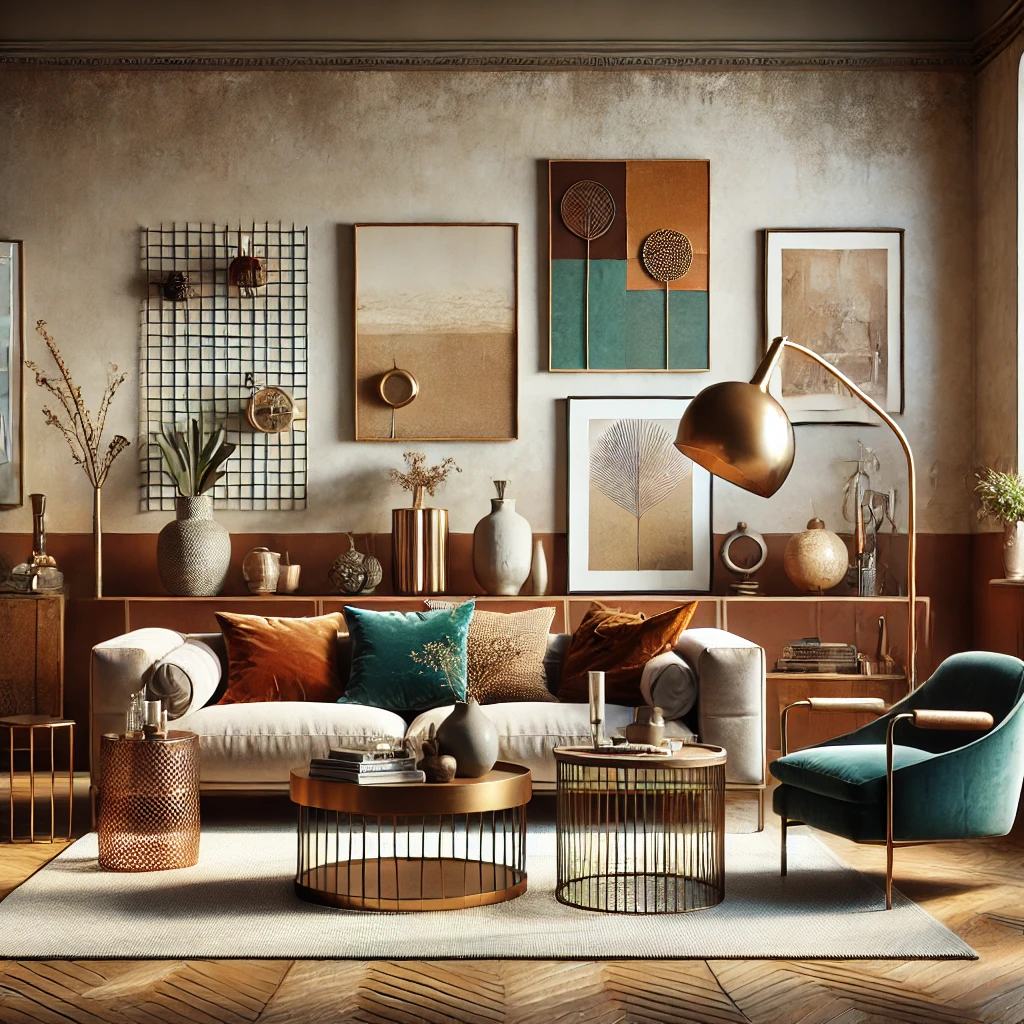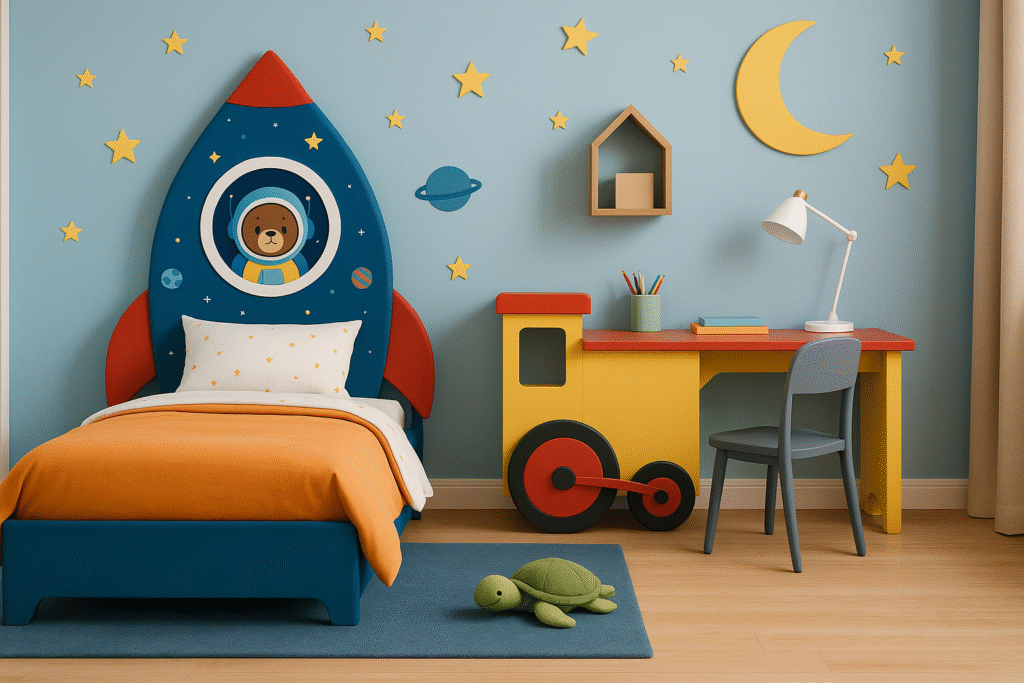The nightstand or bedside table is one of the most crucial components helping a well-designed bedroom strike comfort with functionality. These basic furniture elements improve the overall attractiveness of your bedroom in addition to providing a surface to arrange your nightly needs including lamps, books, and water. Although it provides clever storage options, a chic nightstand or table may serve as a style anchor for your bed.
There is a great range to fit every taste and requirement from classic hardwood stands with drawers to simple floating shelves. Selecting the correct one requires knowing your own storage preferences as well as the design of your space. Whether your taste is for elegant, contemporary designs or classic vintage tables, the correct bedside unit accentuates both utility and style in your room. This guide will go over several styles, characteristics to take into account, fabrics, designs, and current trends so you may boldly pick your ideal bedside friend.
Types of Nightstands: Choosing What Suits Your Space
Different space and aesthetic requirements call for many kinds of nightstands and bedside tables. Usually including one or two drawers, traditional nightstands provide handy space for things like phone chargers, glasses, or notebooks. For individuals who enjoy things kept orderly, these are ideal. For book or décor item placement, open-shelf nightstands offer a more airy and understated look. Modern interiors and tiny bedrooms might benefit from floating nightstands, hung on the wall, which save space.
Choose nightstands with built-in USB ports and power outlets if you wishfor multifunctionality and double as charging stations. Repurposed chests or luggage could be odd yet useful bedside tables for vintage aficionados. High beds go nicely with taller nightstands; low-profile ones fit platform beds. Before deciding, take into account the area that is accessible on either side of your bed and the general room scale. Every kind presents a different combination of use and style.
Key Features to Look for in a Functional Nightstand
Functionality of a nightstand should be first consideration. First consider your storage needs; drawers and cabinets are crucial to hide clutter from view if you store several objects beside your bed. Another important surface is tabletop; make sure it’s broad enough for your personal belongings, light, and alarm clock. Modern convenience in built-in charging stations lets you power your gadgets without adding further clutter.
Think about height compatibility: simple access from your nightstand should coincide with the height of your bed. Another crucial consideration is material durability; if you intend to keep humidifiers or water glasses close-by, pick materials resistant to moisture. Look for solid construction and smooth drawer slides. If you routinely use electronics, cable management holes or notches are helpful. Furthermore consider safety if you have children; rounded edges are safer than sharp corners. Every element enhances the general utility, therefore your nightstand is not only beautiful but also rather useful.
Popular Materials and Their Pros and Cons
Nightstands range in materials, each with unique advantages and design appeal. The most traditional and adaptable material is wood; nightstands made of oak, walnut, or mahogany have ageless appeal and durability. Their weight and cost, meanwhile, could be more of concerns. Though they may seem cold in warm environments, metal nightstands provide an industrial or futuristic edge and are rather robust. Often coupled with metal frames, glass nightstands have a sleek, modern appearance but can be prone to fingerprints and breakage.
Although they are less durable over time, engineered wood or MDF versions are more reasonably priced and come in several colors. Though they have a natural, bohemian feel, rattan or wicker tables might not be appropriate for particularly damp areas. Though they need constant cleaning, mirrored nightstands give tiny rooms glitz and visual spaciousness. Every material has trade-offs in terms of appearance, care, and lifetime; hence, select one that best suits your taste and way of life.
How Style Influences Your Nightstand Choice
The choice of a nightstand that accentuates your bedroom décor depends much on style. Choose clean lines, neutral hues, and concealed storage nightstands for contemporary or minimalist bedrooms. Often constructed from light wood with tapering legs, Scandinavian designs evoke a delicate, airy sensation. Rich wood finishes and detailed hardware—often in darker tones like cherry or mahogany—help traditional interiors.
Matching tables or old items may accentuate and provide character for bohemian or eclectic designs. Workable in loft or urban environments, industrial designs include metal and raw wood components. If you want glitz or luxury, mirrored or lacquered nightstands with gold accents can accentuate elegance. Tables in the wicker or whitewashed styles will help coastal bedrooms. While deliberate contrast may also provide visual interest, matching your nightstand to your bedframe in tone or design will produce harmony. Always give the piece’s fit with the current space atmosphere first priority.
Multi-Functional Nightstands for Modern Living
Nightstands are no exception; furniture in modern houses must be multifarious. Often one elegant object combines storage, digital functions, and even illumination in multi-functional bedside tables. Many more modern designs save clutter by including USB ports, wireless charging pads, or power outlets, therefore removing the need for extension cables. Certain nightstands have built-in speakers or LED lights run under touch or remote control.
For tiny areas, think about nightstands with fold-out trays or movable shelves for extra surface area as needed. Drawer organizers help to maintain accessibility and neatness of objects. For people who study or work from bed, some designs also double as little workstations, which makes them perfect. There is more protection and privacy added by hidden sections. Selecting a nightstand with several uses not only maximizes space but also fits a contemporary, technologically advanced way of life. Search for furniture for your bedroom that fits your daily demands while nevertheless keeping design harmony and flair.
Storage-Oriented vs. Decorative Nightstands
Consider your priorities while choosing between attractive and storage-oriented nightstands. With several drawers or shelves to arrange basics, storage-oriented nightstands prioritize utility. For those who want to store books, devices, medication, and other goods close at hand but out of sight near-by, they are ideal. They simplify look and help to clear clutter. Conversely, ornamental nightstands may function as design statements. They could have minimal storage yet offer open designs, beautiful forms, or opulent materials.
If you have other storage furniture, such as drawers or wardrobes and use your nightstand mostly for a light or a few decorative objects, they work great. A few accent furniture items also help to accentuate the general design of the bedroom. One should find a balance; do not completely give up utility for appearance. Your nightstand should ideally satisfy your everyday storage requirements and also easily accentuate the architectural plan of your room.
Nightstand Placement and Space Optimization Tips
The flow and use of your bedroom may be much influenced by the arrangement of your nightstand. To provide simple access, your nightstand should ideally be level with either slight below the top of your mattress. To prevent crowding, the bed and surrounding walls or furniture should be at least two feet apart. Choosing floating or wall-mounted nightstands with surface area without sacrificing floor space can help smaller bedrooms.
Triangular tables or corner nightstands help to optimize otherwise wasted space. Low-profile, transparent materials like glass or acrylic will help to prevent obstructing light if your bed faces a wall with windows. For visual harmony in shared bedrooms, use symmetrical nightstands. In bohemian or eclectic environments, asymmetrical placement might provide artistic flexibility instead. Match or complement lighting to tie mismatched tables. Careful placement improves access, organization, and the general visual harmony of your bedroom.
Comparison of Popular Nightstand Styles
Here’s a quick comparison of popular nightstand types based on function, style, and ideal use case:
| Style | Key Features | Ideal For | Pros | Cons |
|---|---|---|---|---|
| Traditional | Wood, drawers, ornate handles | Classic bedrooms | Timeless, durable, lots of storage | Heavier, can look bulky |
| Modern/Minimalist | Sleek lines, few/no drawers | Small or sleek modern spaces | Clean look, easy to clean | Limited storage |
| Industrial | Metal & wood combo, exposed bolts | Urban/loft-style décor | Sturdy, trendy | May feel too harsh for some spaces |
| Scandinavian | Light wood, tapered legs | Airy and casual themes | Bright, functional, friendly | Not ideal for heavy storage |
| Glam/Mirrored | Glossy, reflective, luxe accents | Chic or luxurious interiors | Eye-catching, light-reflecting | Requires frequent cleaning |
Current Trends in Nightstands for 2025
2025 nightstand trends all rev around combining digital integration with environmental design. Increasingly popular eco-friendly materials with a natural appearance and sustainability are bamboo, recycled wood, and rattan. Tech-forward bedrooms are starting to have smart nightstands with wireless charging, touch-control lighting, even Bluetooth speakers. Nightstands with vibrant lacquered finishes, combined materials—like wood with leather or metal—and unusual forms are reflecting the “maximalist meets function” trend.
Rounded shapes offer a gentler, safer look than sharp-cornered designs. Modular furniture is another trend whereby your nightstand may change—stack, detach, or slide into other items. Additionally becoming very fashionable for making tiny rooms seem larger are transparent or acrylic nightstands. Matching bedroom sets is giving spaces more individuality as mismatched but coordinated elements take the stage. These trends underline not only aesthetic appeal but also flexibility to new demands, thereby guaranteeing that your furniture stays useful and fashionable for many years.
Conclusion
Selecting the appropriate nightstand or bedside table goes beyond simply complementing your bed; it’s about improving the beauty and utility of your personal environment. There is a nightstand to fit any taste, whether your needs are for lots of storage, tech-friendly tools, or style that fits your taste. To make a wise decisio,n consider your bedroom’s size, bed height, storage requirements, and taste in style.
A nice nightstand pulls together your whole room décor in addition to arranging your evening basics. Consider it as a little outlay in everyday comfort and long-term gratification. From high-tech smart tables to lovely antique finds to simple modern designs to intricate traditional pieces, the ideal nightstand combines functional elements with artistic harmony. Your bedroom will stay a calm, fashionable, and useful haven for years to come if you choose the correct mix of materials, design, and features.
FAQ’s
How can I choose a bedside table that complements my bedroom’s style and color scheme?
Get design tips on selecting materials, finishes, and shapes that enhance your bedroom décor.
What are the key features to look for in a functional nightstand or bedside table?
Understand the importance of storage options, surface space, and accessibility for nighttime essentials.
Are there space-saving nightstand designs for small bedrooms or minimalistic setups?
Discover compact options like floating shelves, slim-profile tables, and multifunctional pieces.
What are some clever ways to style a nightstand for both practicality and visual appeal?
Learn how to balance decor with functionality using lamps, trays, books, and personal touches.
Can mismatched nightstands create a stylish look in a modern bedroom?
Find out how to successfully mix different bedside tables while maintaining a cohesive and chic aesthetic.
| Home Page | Click Here |
| Home Furnishings | Click Here |


